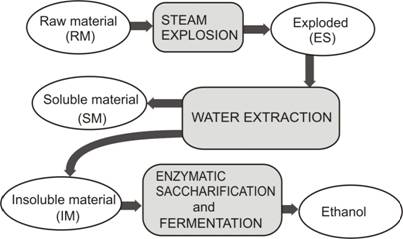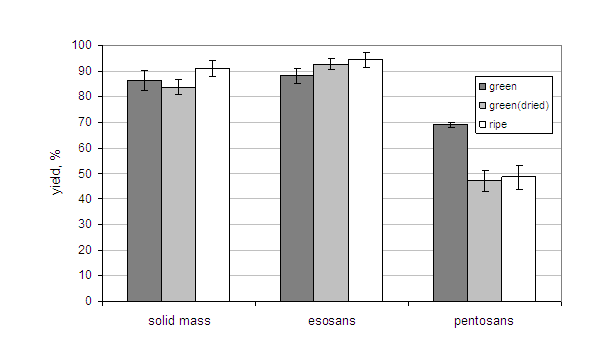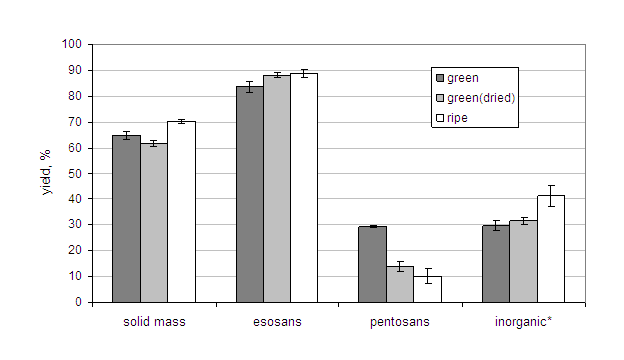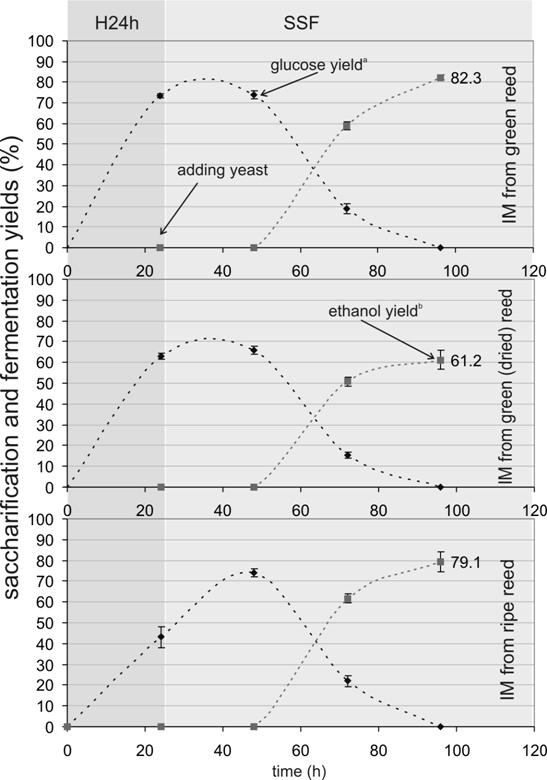1. Introduction
Lignocellulosic biomass will play a key role for the sustainable production of chemicals and biofuels in the future economy. The choice of the feedstock and its availability are critical issues for the production cycle because they have strong effects on yields and cost [1,2,3,4]. As an energy crop the Arundo donax L., commonly known as giant reed, is one of the most promising feedstocks thanks to the high productive potential and carbohydrate content: in optimal conditions it can reach a productivity of 67 t/ha per year [5], and about 60% of the dry stem-wall material is holocellulose [6]. Moreover, the reed is not directly linked to the food chain and requires relatively low amounts of fertilizers and pesticides [7]. For these reasons, the reed is one of the most suitable nonfood crops for bioenergy and bio-compound production [8]. In southern Europe it has been selected as the energy crop for feeding a 2nd generation plant with ethanol production capacity of 40 Gg y−1, operating near the town of Crescentino Vercellese in Italy [9]. The giant reed is a perennial grass and can be harvested for many years although with different yield: an increasing phase from 1st to 3rd year, a steady phase from the 4th to 8th, and a decreasing phase from 9th year onward [7]. The harvesting time affects the quality as feedstock in correspondence with different stages of growth and ripeness of the plant. The different content of hemicellulose, cellulose and lignin along the stem have been pointed out by analyzing the composition of the internodes from the apex to the bottom, and it has been found that the hemicellulose content is 340 g kg−1 in the youngest tissue and 250 g kg−1 in the mature part, while cellulose and lignin content generally increases [10]. With regard to the mineral content, it is 3-4 folds higher in leaves than in stems with significant variation with the ripeness [11]. Although the effect on enzymatic hydrolysis of gross physical characteristics that change during the growth (fiber size, lignin distribution, cell wall thickness, etc.) has long been recognized, detailed studies on this subject are lacking, while this kind of investigation is commonly found for other energy crops [12,13]. Recent works report the pretreatment of the giant reed by dilute acid [6,14] and catalyzed steam explosion [15], aiming at improving the conversion into ethanol or levulinic acid [16]; however, in recent literature specific investigations on the effect of raw material quality are lacking.
This work aimed at investigating how the ripeness of biomass and drying process affect the sugar yield and the following ethanol production from the giant reed, by adopting the sequence of pretreatment, enzymatic hydrolysis and fermentation. The different dry matter of the plants harvested in different seasons and the necessity of drying the biomass for storage have also led to investigation on the effect of this procedure and comparison with natural drying in open field. In fact, the molecules of water participate in the intermolecular forces among the fibers with hydrogen bonds. Hornification is a well-known phenomenon in papermaking when the pulp paper undergoes wetting and drying cycles with consequent reduction of water holding capacity, fiber surface fibrillation, pore size distribution and lower tensile strength [17]. Beside the mechanical degradation of the fibers, this change of morphology at microscopic scale also affects the enzymatic hydrolysis of chemically pretreated substrates like wood and corn stover [18,19]. As reduction of humidity is a basic requirement for storage and processing, it is worth investigating the related effects on feedstock quality for sugar and biofuel production [20,21].
2. Materials and Method
Localgiant reed was used as starting raw material. The plants were collected at two ripeness times: 1) as the plant reached its maximum growing phase in May, i.e. 3-4 m of height, and 2) in late July, after 12 weeks from the first sampling, i.e. when the stems started to yellow and dry. The whole plants (leaves, stem, and inflorescence) were collected by cutting the stem at 0.1-0.2 m from the soil, and then were ground with a knife-cutting machine equipped with a sieve with holes of 25 mm.
In the laboratory the biomass were subjected to the sequence of steam explosion, water extraction, enzymatic hydrolysis and fermentation, as schematized in Figure 1. The Steam Explosion (SE) parameters were chosen on the basis of a preliminary work of optimization (data not reported). Three conditions were tested changing the stage of maturity of the reed and the drying conditions:
1) Fresh reed with moisture content of 750g kg−1, chopped and steam exploded. This condition corresponded to the processing of fresh crop.
2) Fresh reed, chopped and oven dried at 60 °C overnight then humidified to 750 g kg−1 before SE. This condition corresponded to an artificial drying.
3) Ripe fresh reed, chopped and humidified at 750 g kg−1 then steam exploded. This condition corresponded to the processing of ripe crop.
The reed was treated in a SE batch reactor at 210 °C for 10 minutes. These conditions correspond to relatively high severity, quantified empirically as logRo 4.24, where the severity parameter (Ro) is defined by the empirical equation Ro = t × exp[(T−100)/14.75)], where t (min) is the reaction time and T (°C) is the temperature of the saturated steam [22]. The SE reactor was a vessel made of stainless steel having a capacity of 0.01 m3, the chamber was surrounded by a steam jacket so that, when it was working, the internal and external temperatures are the same and the vapor condensation was minimized. Biomass was introduced in the reactor through a pneumatic loading valve and then soaked with saturated steam. After the elapsed time, the blow valve was opened, pressure decreased in a very short time and the biomass was discharged in a storage tank of 0.15 m3 from which it was recovered after that the pressure reduced to the atmospheric value. Samples of 0.5 kg of reed (Dry Matter, DM) were treated in each run; three runs were carried out to produce the batch of material used for the chemical analysis and the experiments of bioconversion. The exploded reed was a slurry containing about 200 gDM kg−1.
The steam exploded reed was collected and extracted with water at 60 °C in order to recover the hemicellulose and to remove inhibitors; the analytical procedure and details are reported elsewhere [23].
The enzymatic hydrolysis and the fermentation were carried out in 0.1 l flasks (0.05 l working volume) by adding the yeast Saccharomyces cerevisiae at 35 °C 24 h after the enzymatic saccharification was started and carried out at 45 °C. This procedure is reported as H24h-SSF (Hydrolysis of 24 h followed by Simultaneous Saccharification and Fermentation) [24]. By this procedure the formation of lactic acid was avoided [25] and, moreover, the pre-hydrolysis phase allowed to better exploit the higher activity of the enzyme to homogenize the slurry in shorter time, so enhancing the mixing efficiency of the shaking [26,27]. A mix of enzymes was used, i.e. Celluclast 1.5 L (65 FPU g−1 and 17 b-glucosidase IU g-1), supplemented with the b-glucosidase Novozyme 188 (376 b-glucosidase IU g−1), from Novozymes A/S (Denmark). The ash content in raw and exploded materials was determined by sample combustion at 600°C (AMST-1106, modified). The extractives content in the straw was determined by soxhlet extraction, using a 2:1 mixture of toluene and ethanol for 6 h. Carbohydrates content was determined by hydrolysing the dried solid materials with sulphuric acid (Klason method), and determining the lignin as precipitate. Glucose, galactose, xylose and arabinose in the filtered liquid fraction, were determined by Hhttps://www.aimspress.com/aimspress-data/aimsboa/2015/2/PIC (Dionex DX 500) using a Carbopak PA1 column, an amperometric detector and a 1.0 mL/min flow of 2-200 mM NaOH as eluent. Ethanol was determined in the centrifuged sample from the fermentation broth by Hhttps://www.aimspress.com/aimspress-data/aimsboa/2015/2/PIC (Dionex DX 500) using as eluent H2SO4 10 mM, a column Nucleogel 300 OA and a RI detector. The tests of H24h-SSF were performed in duplicate, analytical determination in triplicate, the average values are reported in the tables and figures with their standard deviation.
3. Results and Discussion
The compositions of the raw materials are reported in the Table 1.
Table 1. Composition of fresh green reed (RMgreen) and ripe reed (RMripe): dry matter and macro constituents
| a) dry matter; b) ash at 600°C |
|
|
RMgreena
g kg-1
|
sd
|
RMripea
g kg-1
|
sd
|
|
Dry matter
|
244
|
1
|
805
|
1
|
|
glucan
|
321
|
10
|
378
|
4
|
|
galactan
|
16
|
1
|
28
|
1
|
|
arabinan
|
31
|
1
|
47
|
1
|
|
xylan
|
162
|
8
|
193
|
1
|
|
extractives
|
75
|
8
|
43
|
1
|
|
inorganicsb
|
92
|
1
|
51
|
1
|
|
Klason lignin
|
269
|
2
|
249
|
4
|
|
ND
|
33
|
|
10
|
|
In ripe reed the carbohydrate content was higher, especially glucan (cellulose), while the lignin, inorganics and extractives were less abundant. The acid insoluble residue from the Klason procedure, generally referred to as lignin, was lower in the ripe reed, in apparent disagreement with previous phytochemical studies [10]. Overestimation of the lignin is reported for kraft pulp because of residual extractives such as sterols, steryl esters, fatty acids and hydrocarbons that affect the Klason method [28,29,30]. Mineral translocation from leaf tissues to rhizomes during crop natural drying can explain the lower content of inorganics of ripe reed; moreover, as the plant grows or dries, it loses leaves which are the part richer in minerals [11]. These differences of chemical composition are important because a higher content of carbohydrates, glucose in particular, potentially leads to higher yield of ethanol. The fresh reed had a high water content (750 g kg−1 vs 200 g kg−1 of the ripe reed), which implies higher cost for transport and higher consumption of steam in the pretreatment step. The accessibility of cellulose by the enzymes, the lignin content and gross physical characteristics such as fiber size and cell thickness, play a role in the hydrolysis and the relationship between the composition of the biomass and the final yield of biofuel is not directly correlated [12]. The combination of these factors could make a biomass with a higher percentage of carbohydrates less attractive than one poorer, but more fully exploitable.
The compositions of the steam exploded reed are reported in Figure 2. The amount of not determined material of the exploded substrates was relatively high; it is non volatile organic material that derived from the transformation of hemicellulose and lignin during the treatment and from other organic compounds like extractives and chlorophyll.
The effects of SE on the biomass were different depending on the initial conditions of the raw material and the preconditioning procedures. The recovery of the main macro-constituents after the treatment is reported in Figure 3. As general trend, the recovery of solid was not complete because of the conversion of pentosans to volatile compounds; this phenomenon was enhanced in the dried substrates (recovery < 50%), while nearly 70% of hemicellulose was recovered in the fresh green reed. The hexosans (cellulose) were more resistant and for all the three substrates the recovery was about 90%. In this work, as ethanol was obtained exclusively by hexosans, SE treatment did not depress excessively the final yield, because only 10% of cellulose was degraded.
Figure 4 shows the recovery of the macro-constituents from the pretreated reed by aqueous extraction of the insoluble residue. The yields were calculated on the basis of the composition of the starting raw material. The data reported point out that the aqueous extraction removes mainly hemicellulose; this removal was higher in the ripe reed and in the dried green reed than in the fresh green reed. Most of the inorganic matter passed into the aqueous phase.
The insoluble solids, without drying, were tested for enzymatic hydrolysis and fermentation, in order to verify the effectiveness of the SE treatment on the improvement of the sugar and ethanol yields.
The overall yields of glucan conversion into ethanol and chemical composition of the substrates were combined to assess the mass balance for the conversion into ethanol of the 3 feedstocks. Table 2 shows the obtained values referred to each stream; the best ethanol yield was achieved in the case of the ripe reed. The yields of enzymatic hydrolysis of cellulose achieved from the fresh green reed and from the ripe reed are similar (82% vs. 79 % of the theoretical). In the case of the fresh green reed, a better recovery of hemicellulose and a lower mass loss in SE can be achieved, but the higher content of cellulose in the ripe reed leads to recovery of more free glucose available for the fermentation. The dried green reed showed the lowest production of ethanol, because part of the cellulose remained unconverted in the hydrolysis. It is suggested that drying preconditioning led to hornification of the fibers, likewise reported for pulp paper [18,19].
Table 2. Mass balance of the conversion of reed in sugars and ethanol by H24h-SSF (g kg−1DM of feedstock)
| a comprising lignin, extractives, ND. |
|
|
Green reed
|
Exploded green reed
|
IM
|
SM
|
EtOH
|
|
hexosans
|
337
|
297
|
281
|
16
|
|
|
pentosans
|
192
|
133
|
56
|
77
|
|
|
inorganic
|
92
|
92
|
27
|
65
|
|
|
othera
|
378
|
341
|
284
|
57
|
|
|
total
|
1000
|
864
|
650
|
214
|
132
|
|
|
Green dried reed
|
Exploded green dried reed
|
|
|
|
|
hesxosans
|
337
|
313
|
297
|
16
|
|
|
pentosans
|
192
|
90
|
27
|
63
|
|
|
inorganic
|
92
|
92
|
29
|
63
|
|
|
othera
|
378
|
342
|
266
|
76
|
|
|
total
|
1000
|
838
|
619
|
219
|
103
|
|
|
Ripe reed
|
Exploded ripe reed
|
|
|
|
|
hexosans
|
407
|
384
|
361
|
23
|
|
|
pentosans
|
240
|
116
|
24
|
92
|
|
|
inorganic
|
51
|
51
|
21
|
30
|
|
|
othera
|
302
|
359
|
297
|
62
|
|
|
total
|
1000
|
911
|
704
|
207
|
162
|
4. Conclusions
The production of sugars and ethanol from giant reed was affected by its ripeness and by the eventual drying step. Ripe reed contains more carbohydrates than green reed (647 g kg−1 vs 515 g kg−1), and the resulting sugar and ethanol production was higher, in spite of 3% lower saccharification yield. While drying fresh biomass is good practice for biomass preservation, it negatively affects the recovery of free sugars and ethanol production, because of fiber hornification which hinders enzyme access in the hydrolysis step. After the sequence of SE pretreatment, enzymatic hydrolysis and fermentation by S. cerevisiae 132 g; 103 g; 162 g of ethanol; and 77 g; 63 g; 92 g of pentosans were respectively obtained from 1 kgDM of fresh green reed; dried green reed or ripe reed.
Conflict of Interest
The author declares no conflicts of interest in this paper.










 DownLoad:
DownLoad: 











